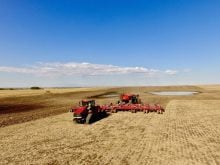All insects can be influenced by weather conditions during the growing season. When pests and their predators respond to weather changes in a similar way, natural enemies can be effective at controlling pest populations. Unfortunately for farmers, that’s not always the case.
Meghan Vankosky, a research scientist in field crop entomology at Agriculture and Agri-Food Canada in Saskatoon, Sask., says insects have a complex relationship with temperature and rainfall. Understanding how pests and their natural enemies respond to these parameters can help to predict populations and what type of management may be needed.
Grasshoppers, for example, rely on external temperature for development and activity and are more active at higher internal body temperatures. But the fungal pathogens that can reduce grasshopper populations, like Entomophaga grylli, tend to be more prevalent in cooler and wetter conditions.
Read Also

Claas brings 1000 Series SP forage harvesters to Canada
In mid-August, Claas unveiled its new line of Jaguar forage harvesters at an event in Visalia, California, deep in the heart of that state’s dairy region.
While it is not clear how high temperatures affect wheat stem sawfly populations, Vankosky says hot and dry conditions negatively influence its natural enemy, a parasitoid called Bracon cephi. Over the course of a few years, this means pest populations can increase because they are escaping natural control.
Conversely, Jim Tansey, a provincial entomologist for the Saskatchewan Ministry of Agriculture, says that the development of pea aphids is restricted at higher temperatures, but the activity of invasive ladybug species increases with heat.
The life cycles of wheat midge and its natural enemy Macroglenes penetrans are closely linked, meaning weather conditions that positively affect the pest population are likely to have the same effect on the predator.
Lygus bugs tend to prefer warmer temperatures and can be significantly affected by fungal pathogens under high relative humidity. Rainfall can also control pest populations as raindrops can knock young lygus onto the ground where they can drown or encounter other natural enemies.
Rain can have a similar effect on diamondback moth populations because the larvae are small and can easily be knocked off. Since some of the parasitoids that attack these moths overwinter in Canada and some don’t, the effect they have varies depending on where the pest population is located and which species are present.
For more information on the pests and predators in your fields visit fieldheroes.ca for a free Pests & Predators Field Guide, crop scouting and pest scouting guides, sweep net scouting tips, sweep net video series, Pest & Predators podcast series and more.
The Field Heroes campaign was developed and is funded by WGRF to increase awareness of beneficial insects and the important role they play in pest management.















